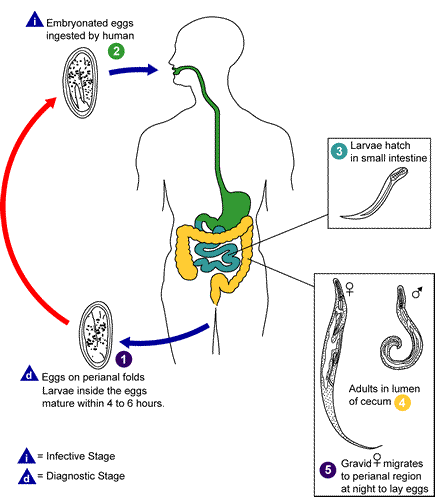Vaizdas:Enterobius vermicularis LifeCycle.gif
Enterobius_vermicularis_LifeCycle.gif (435 × 497 taškų, rinkmenos dydis: 17 KiB, MIME tipas: image/gif)
Rinkmenos istorija
Paspauskite ant datos/laiko, kad pamatytumėte rinkmeną tokią, kokia ji buvo tuo metu.
| Data/Laikas | Miniatiūra | Matmenys | Naudotojas | Paaiškinimas | |
|---|---|---|---|---|---|
| dabartinis | 20:27, 15 gruodžio 2012 |  | 435 × 497 (17 KiB) | Cartoffel | watermark removed |
| 21:50, 13 gegužės 2006 |  | 435 × 497 (21 KiB) | Patho | {{Information| |Description=Enterobiasis [Enterobius vermicularis] Life cycle of Enterobius vermicularis Eggs are deposited on perianal folds. Self-infection occurs by transferring infective eggs to the mouth with hands that have scratched the peria |
Paveikslėlio naudojimas
Paveikslėlis yra naudojamas šiuose puslapiuose:
Visuotinis rinkmenos naudojimas
Ši rinkmena naudojama šiose viki svetainėse:
- Naudojama ba.wikipedia.org
- Naudojama ceb.wikipedia.org
- Naudojama da.wikipedia.org
- Naudojama de.wikibooks.org
- Naudojama en.wikipedia.org
- Naudojama es.wikipedia.org
- Naudojama fa.wikipedia.org
- Naudojama hy.wikipedia.org
- Naudojama ml.wikipedia.org
- Naudojama nl.wikipedia.org
- Naudojama pa.wikipedia.org
- Naudojama pt.wikipedia.org
- Naudojama ru.wikipedia.org
- Naudojama szy.wikipedia.org
- Naudojama th.wikipedia.org
- Naudojama vi.wikipedia.org
- Naudojama zh.wikipedia.org



